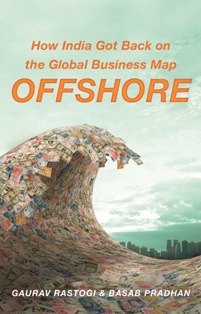“Offshore How India got back on the Global Business map” is what the authors set out to explore or maybe explain. The book tells you about what you probably do not know about the offshore industry if you are not a part of it. If you are a part of the industry, there is not a thing in the book that you would not know. Now that defines the audience of this book very clearly: World – people in offshore-industry – those who engage with the offshore industry as clients. Now, this audience can be divided into two – Indians and Non-Indians. I think the authors oscillated between these audiences. Sometimes they wanted to address the concerns of Indians. And sometimes they wanted to explain small things about India the way only a non-Indian audience requires.
It starts by talking about the cynicism that outsiders have about the people working in this industry. And the use of terms like cyber coolies. And the fact that people think that only reason that this industry exists is due to the Indian engineers are cheaper than the ones in developed-world. In the first two chapters, they set the context for the offshore and then they go on to explain what is Offshore. And why it works for both the industry and the clients. They take some simple daily life examples to explain how the outsourcing and offshoring work. And what is the difference between the two? They also try to explain the idea of domain knowledge and specialization that comes at a cost. And how an outsourcing vendor can help clients rationalize this cost.
They explain Global Delivery model which is essentially delivering projects with a team that is scattered around the globe. In different time zones, in fact, taking advantage of the same. The issues that come with GDM and how the industry addresses them. They go on to explain why India is and will continue to be the preferred offshore destination for knowledge industry. They explain the difference between the captive offshore companies and independent offshore industry. By explaining the pros and cons of both and indicating what is preferred when. Though their inclination is always towards industry and they both belong to it.
They address the challenges that this industry faces. Like hiring engineers in thousands in a short window of time. And maintaining the fine balance of hiring people and deploying them on projects. Even a little loss in balance can lead to a dip in profit margins for the company. They talk about the challenges of sales-team and here I think they go overboard and lose the outsider’s focus. And end up explaining their own pains and challenges. It would have been nice to get some client’s perspectives also. Their fear of sending sensitive and important work across the globe, a world they hardly know anything about. There is a good explanation of various types and levels of services the industry provides and how it bills its clients.
I found last two chapters not so exciting. And I think they came from topics that are too close to the authors, both of them being sales guys.
I really like the chapter ‘What makes a company Indian’. This essay looks at all the factors that common sense can think of calling a company Indian or for that matter any nationality, but upon exploring a level deeper, you would realize that this does not match with the common perception of the company. A very interesting look at the multinationals in this globalized world. Another interesting chapter is on “Why can’t India produce a Microsoft?” For the layperson, they explain the difference between a product and a services company. And that India has incidentally developed itself as a services hub and it has its reasons for the same. I think this is an explanation that was needed for all those who keep asking this question. For me, this is like asking “Why can’t we grow black pepper in Kashmir or apples in Kerala?”
A good read for anyone who finds this industry mysterious and all those who wonder what do these young engineers do get paid so well. A good guide to an industry that has changed the branding of India in the last couple of decades and made us a country of software geeks from snake charmers. I still remember an incident when someone at a European airport walked up to a colleague of mine with his laptop and said, you look Indian, can you please repair this for me…that is what we stand for now.
Personally, reading this book was a trip down the memory lane…bringing back a lot of memories from 12+ years that I spent in this industry.
Read the author Gaurav Rastogi interview with Anu Reviews.






